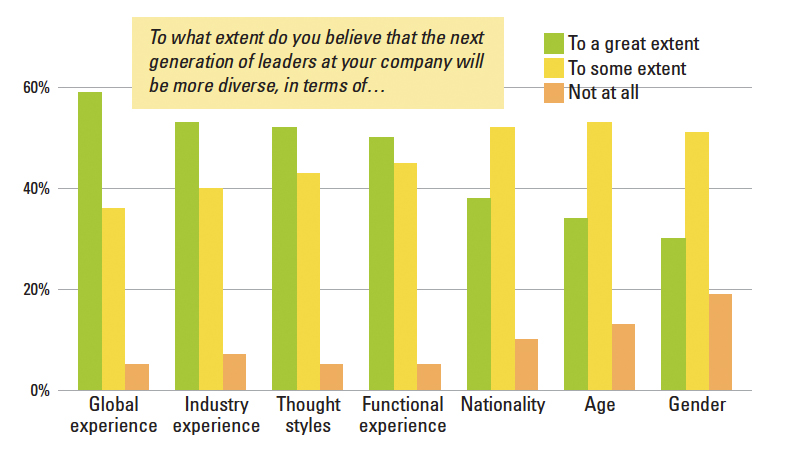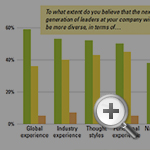Developing Tomorrow’s Global Leaders
Human resources executives believe the next generation of global executives will be more diverse. Are companies ready?
Large global companies today are increasingly led not so much by an individual or even a single team, but by an ensemble of leaders. Consisting of the top one or two percent of executives and experts, ensembles bridge a host of differences — in language, culture, time zones, experience and more. They also make it easy for groups of leaders to configure themselves according to the task at hand.
How are human resource executives at global companies preparing for a future that includes such diverse leadership groups? To find out, we surveyed 197 HR executives from global companies in 2012. We defined global companies as those operating in four or more countries across two or more continents. The companies we surveyed met these criteria, and they represented a wide variety of industries and company sizes.
The HR executives we surveyed said they believe that top leadership groups in the future will be characterized by people with greater diversity of experience and “thought styles” — for example, more analytical vs. more “by the gut” — even more than by diversity of age, nationality and gender. (See “Critical Areas of Diversity for Next-Generation Global Executives.”) “The future leaders of the company will be more diverse. Diverse in terms of race, gender and so on, but also in terms of their experiences,” observed Ellen Dubois du Bellay, senior vice president of executive office operations at Four Seasons Hotels and Resorts. “We will always make better decisions from this vantage point.”
Critical Areas of Diversity for Next-Generation Global Executives

However, HR executives are not giving priority just to a broad focus on diversity. More than 90% of the HR executives we surveyed also believe that next-generation leaders will be working more collectively in the future. Taken together, these two findings suggest that leaders from highly diverse backgrounds will need to work together more effectively.
Frustratingly, however, it’s often difficult to promote both diversity and collective action at the same time. Research has found that diverse groups will likely experience more disagreements about their tasks and group processes than homogeneous groups. What’s more, foot-dragging on decisions, along with counterproductive debates about how to get things done or which data are “right,” can spawn severe dysfunction in a leadership team. But now, with diversity and collective action both important, the question of how to reconcile the two imperatives has become more pressing.
How are HR executives grooming the next generation of leaders to address these challenges successfully? Companies traditionally have used a variety of methods to develop future leaders — including coaching, mentoring, strategic job assignments, action learning, personality assessments and 360-degree feedback. These methods often focus on the characteristics, mindsets and potential of individual leaders. Companies that were most confident that their leadership-development programs equip high-potential employees for leadership success — a small subset of our total sample — reported having more formal policies aimed at developing leaders individually. But, critically, they also reported having more formal policies aimed at developing leaders collectively.
HR leaders who reported the highest degree of confidence in their leadership development programs are more likely to tailor those programs for a diverse audience. Almost 70% of those highly confident executives said that their initiatives reflect their company’s global footprint for diversity — versus only 20% for companies that had a lower degree of confidence in their programs. The HR executives with the highest confidence in their development programs also recognize that diversity extends to learning styles — individuals respond in different ways to teaching, coaching, mentoring and action learning. They therefore avoid taking a one-size-fits-all approach to learning. Finally, they measure the results of their initiatives.
We did not find significant differences between the most confident HR executives and their peers in terms of what they prefer to measure. However, we saw that the HR executives most confident in their companies’ programs are more inclined to understand the measurements and are more willing to recalibrate their programs in light of performance on the metrics they track.
Global leadership development in an age of leadership by diverse ensembles of executives will increasingly require a new approach. HR professionals recognize the value of such an approach, though they also acknowledge roadblocks to achieving the new mindset. In particular, at least 40% of those surveyed cited constrained budgets, limited time, administrative complexity and inadequate accounting for cultural differences. However, those who can surmount the roadblocks and help their companies build diverse global leadership ensembles will stand the best chance of maximizing returns on their leadership development investments.


 View Exhibit
View Exhibit